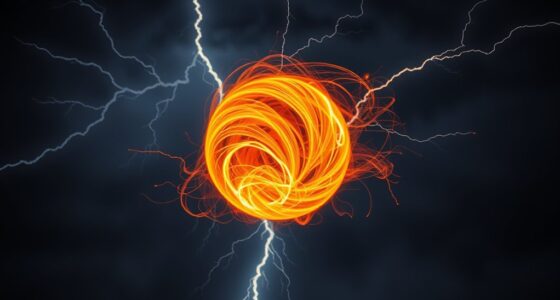You might find it surprising that neutrinos, or “ghost particles,” detected in Antarctica, are defying current physics. These particles rarely interact with matter, but recent discoveries show some behave unexpectedly, with energies beyond known limits. This puzzles researchers, as it challenges the Standard Model and hints at new physics beyond current understanding. If you want to uncover how scientists are tackling these mysteries and what they might mean for the universe, keep exploring.
Key Takeaways
- Recent neutrino detections in Antarctica show energies exceeding known physical limits, challenging existing models.
- Ice core analysis reveals ancient neutrino signals that suggest sources beyond current physics understanding.
- Unusual neutrino behaviors indicate potential new physics phenomena, prompting reevaluation of the Standard Model.
- Anomalies observed are linked to cosmic events that cannot be explained by current theories.
- Advanced AI tools are helping researchers decipher these puzzling neutrino signals, hinting at revolutionary discoveries.

Deep beneath Antarctica’s ice, scientists have detected elusive particles known as neutrinos, often called “ghost particles” because they rarely interact with matter. These particles pass through entire planets without leaving a trace, making their detection a formidable challenge. Yet, through innovative techniques like neutrino detection, researchers have managed to catch glimpses of these nearly invisible travelers. The key to their success lies in the massive detectors embedded deep within the ice, which sense the faint flashes of light produced when neutrinos collide with atoms. This breakthrough has opened a new window into understanding the universe, but recent findings are raising even more questions. Unexpected observations suggest some neutrinos behave in ways that defy current physics laws, hinting at phenomena scientists haven’t yet explained.
Neutrino discoveries beneath Antarctica challenge physics and reveal cosmic mysteries we have yet to understand.
Meanwhile, ice core analysis plays a vital role in unraveling this mystery. By drilling deep into Antarctica’s ice sheet, scientists extract ancient ice layers that contain invaluable clues about past cosmic events. These ice cores hold trapped particles, gases, and isotopes that help researchers piece together the history of neutrino flux over millennia. When combined with neutrino detection data, ice core analysis allows scientists to correlate cosmic activity with changes in the Earth’s environment, potentially revealing why some neutrinos behave unpredictably. You can imagine how these layers serve as natural archives, preserving signals from space that predate human history. Additionally, advancements in particle physics are crucial for interpreting these unusual neutrino behaviors and pushing the boundaries of existing theories.
What’s truly baffling is that some detected neutrinos seem to break the expected energy limits, suggesting they might originate from sources beyond what our current physics predicts. These anomalies challenge the Standard Model, forcing scientists to reconsider longstanding theories about particle behavior and fundamental forces. AI security technologies, such as pattern analysis and anomaly detection, are increasingly being utilized to uncover unusual particle behaviors in data sets. You might think of it as a cosmic puzzle, with each neutrino detection adding a piece that doesn’t quite fit. The implications are profound, hinting that the universe’s laws may be more complex or different than previously thought.
As researchers continue to analyze data from ice cores and enhance neutrino detection technology, the mysteries deepen. These ghost particles, once considered mere cosmic messengers, now seem to carry secrets that could revolutionize physics itself. For you, understanding this puzzle means recognizing how Antarctica’s icy depths are not just a frozen frontier but a gateway to uncovering the universe’s most profound secrets. The ongoing quest to decode neutrinos’ behavior promises to reshape our understanding of the cosmos, making Antarctica a pivotal site for scientific discovery.
Frequently Asked Questions
What Are Ghost Particles Made Of?
You might wonder what ghost particles are made of. They’re actually known as neutrinos, tiny subatomic particles with unique properties. Neutrinos result from various particle decay processes, and they rarely interact with matter. Their elusive nature makes understanding their properties challenging. Despite ongoing research, scientists continue to explore neutrino properties, like mass and oscillation, to uncover the secrets behind these mysterious particles and why they seem to defy known physics.
How Are Ghost Particles Detected?
Imagine catching whispers from the universe’s secrets—this is how you detect ghost particles. You rely on advanced detector technology that captures neutrino oscillations, which happen when neutrinos switch flavors. Large, sensitive instruments like ice or water Cherenkov detectors observe faint flashes of light caused by neutrinos passing through. These signals reveal the elusive ghost particles, helping you decipher mysteries of the cosmos hidden within Antarctica’s icy depths.
Do Ghost Particles Interact With Matter?
You might wonder if ghost particles interact with matter. They rarely do because particle-antiparticle interactions are incredibly subtle, making these particles difficult to detect. Their elusive nature hints at profound quantum field implications, suggesting they could be more than just standard particles. If they do interact, it’s so faint that it challenges current physics understanding, pushing scientists to explore new theories about how matter and these mysterious particles connect.
Could Ghost Particles Be a New Form of Matter?
You wonder if ghost particles could be a new form of matter, and it’s possible. They might relate to dark matter, which we understand interacts weakly with normal matter. Their strange behavior could also involve quantum anomalies, suggesting they’re not just particles but perhaps a new state of matter. Studying these particles might reveal insights into the universe’s unseen components, opening doors to understanding dark matter and fundamental physics.
What Implications Do Ghost Particles Have for Physics?
Imagine discovering a new particle that challenges your understanding of physics. Ghost particles could revolutionize our view of dark matter, offering clues to its elusive nature. They might also reveal quantum anomalies, pushing scientists to rethink existing theories. This discovery could open doors to new physics, prompting us to explore beyond current models and possibly unbolt the universe’s deepest secrets, transforming our grasp of reality itself.
Conclusion
Just like elusive ghosts slipping through your grasp, these particles challenge what you think you know about the universe. They remind you that nature holds secrets beyond your understanding, urging curiosity to lead you into uncharted territory. Sometimes, the most mysterious things aren’t meant to be fully understood—they’re whispers from the cosmos, inviting you to keep searching, keep questioning. Embrace the unknown, for it’s where true discovery begins, lurking just beyond the edge of what you believe is possible.









